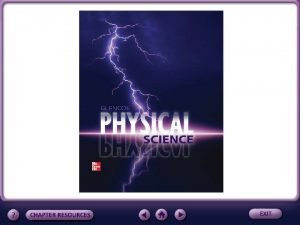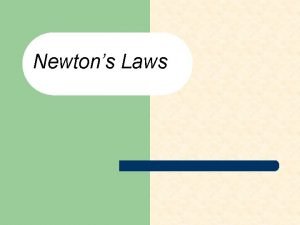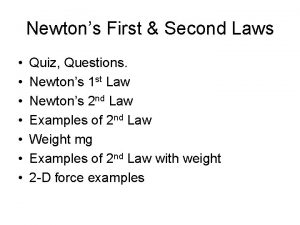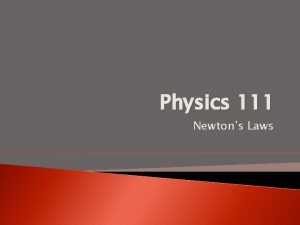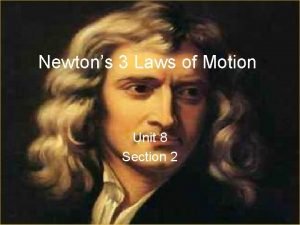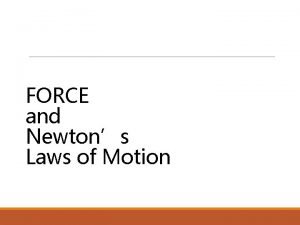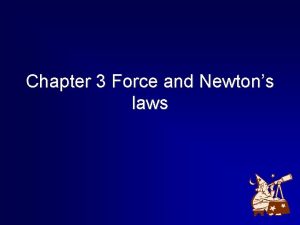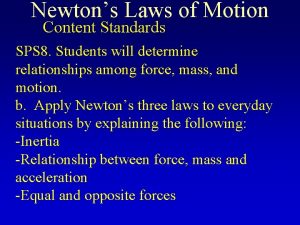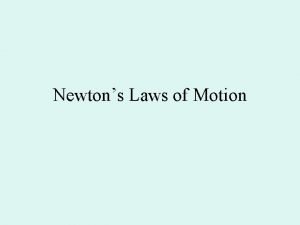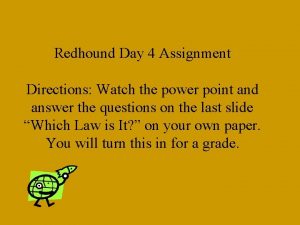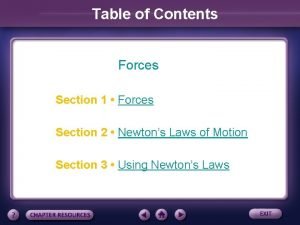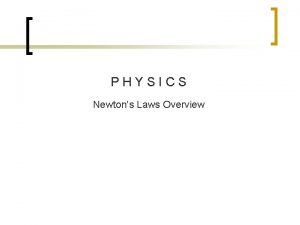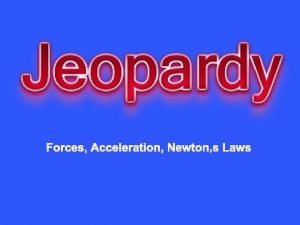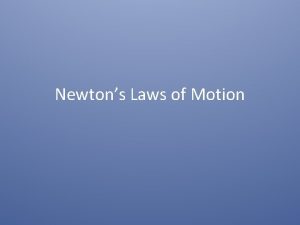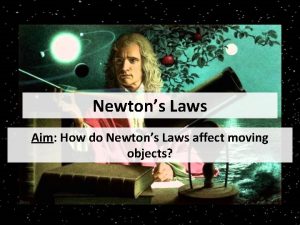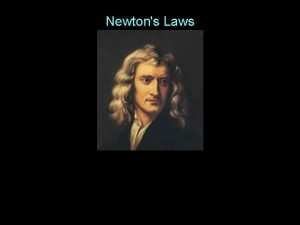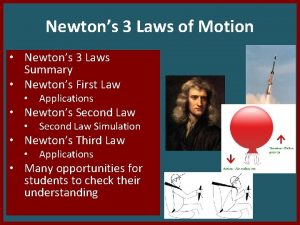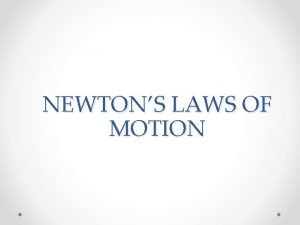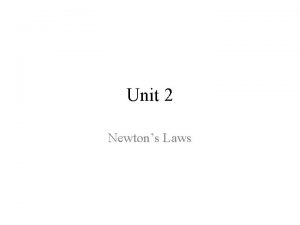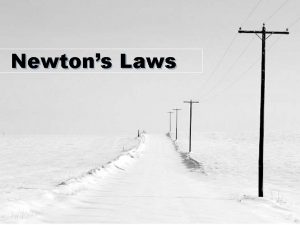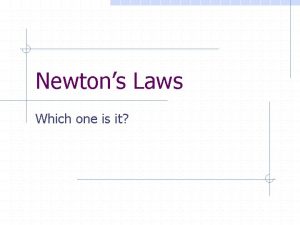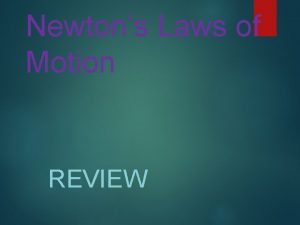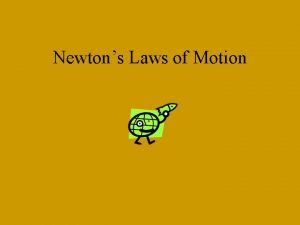Newtons Laws Divisions of Physics u 2 Divisions



















- Slides: 19

Newton’s Laws

Divisions of Physics u 2 Divisions of Physics – Classical Mechanics (Newtonian Physics) u Treats energy and matter as separate entities u Uses Newton’s three Laws to predict motion u Accurately predicts and describes the behavior of large scale objects u Connects acceleration and force – Quantum Mechanics u Studies motion and energy of atoms and subatomic particles u Studies microscopic objects that move at the speed of light (c=c 3. 00 x 108 m/s)

Newton’s 1 st Law u Newton uses 3 Laws to predict force and motion interactions for macroscopic objects “ an object at rest or in uniform motion will remain at rest or in motion unless acted on by an external force”

u The First Law is often interpreted as saying that objects resist changes in motion. This resistance to motion changes is often given the name inertia. Objects with large inertia resist changes in motion better than objects with small inertia.

Newton’s 2 nd Law “ the acceleration of a body is directly proportional to the net force acting on it and inversely proportional to its mass” a = Fnet / m or Fnet =ma where – Fnet = net force (N) m = mass (kg) a = acceleration (m/s 2)

Newton’s 3 rd Law “When an object exerts a force on a second object, the second object exerts a force on the first that is equal in magnitude but opposite in direction” “for every action there is an equal and opposite reaction” action – reaction pair

Determining Net Force

Force in Two Dimensions u Sometimes the direction of the net force is not clear. You must find the magnitude and direction of the net force by adding vectors u Sample problem – page 172

Multi-mass Problems u Tension in ropes and cables When a force is exerted on one end of a cable, each particle in the cable exerts and equal force on the next particle in the cable, creating tension through the cable. Tension is the magnitude of the force exerted on and by a cable.

To avoid complicated mathematics we make several assumptions about cables and ropes: u u u The mass of the rope or cable is so much smaller than the mass of the load that it does not significantly affect the motion or forces involved The tension is the same at every point in the rope or cable If the rope or cable passes over a pulley, the direction of the tension forces changes, but the magnitude stays the same. (pulley is frictionless and its mass ins negligible.

Assigning Direction to the motion of Connected Objects: u When two objects are attached as in an Atwood machine, they are running in two different directions. However, connected objects move as a unit. u System – working with more that one object at a time u Internal forces - the forces exerted through the rope or the cable, between any two objects in the system. Internal forces do not affect the motion of the system. u External forces - forces such as gravity, or friction that affects the whole system. External forces do affect the motion of the system. u When you set up the system you must assign direction from one side of the cable to the other. Left is often negative and right is positive. u Now you are ready to do some multi-massed questions

Momentum u In a very simplistic (and nonphysics) fashion, momentum can be described as the amount of "oomph" an object has. A slowly moving bus and a speeding bullet are very different objects, but you wouldn't want to be hit by either one! The momentum of an object is defined as the product of its mass and velocity,

Momentum u p = mv p is the object's momentum m is its mass (kg) v is its velocity (m/s) u The units of momentum are simply kg m/s u A very important point is that momentum is a vector. It has direction. Another point is that the momentum discussed in this section is more specifically linear momentum. .

Momentum u The changes in an object's momentum could arise because its velocity changes. Of course, its mass may change, but you will learn more about that later. Anytime the velocity of an object changes, there must be acceleration and, as Newton pointed out, acceleration is a result of a net force. If you put all this together: u Impulse – the product of the force exerted on an object and time interval over which the force acts J = F Δt J – impulse (Ns) F – force (N) T – time interval (s) Do questions 29 -32 page 199

The Impulse – Momentum Theorem We use the average force because when impulse is calculated over a very short time interval, force changes continually throughout the few milliseconds of contact of the two objects u It is not always easy to calculate impulse in these situations so …. . an alternate method is to analyze the monentum before and after an interaction between tow objects u

u F Δt = Δp pb – pa m(vf –vi)

Impulse and Auto Safety u One of the most practical and important applications of impulse is the design of automobiles and their safety equipment u Collisions –mass stays the same -momentum goes to zero

u Can not reduce the change in momentum therefore can not reduce the impulse F Δt = J (constant) If you increase the time interval of interaction the average force exerted on the car occupants is reduced Enter – crumple zones – see diagram pg. 203 Other examples of increased time intervals in order to decrease Force – lining of safety helmets that compress relatively slow

Conservation of Momentum u The total momentum before the collision equal the total momentum after the collision u pi = pf u m 1 v 1 +m 2 v 2 = m 1 v 1’ +m 2 v 2’
 Section 3 using newtons laws
Section 3 using newtons laws Second law of motion examples
Second law of motion examples Newton's first and second law quiz
Newton's first and second law quiz Ethan is dragging a bag of grass
Ethan is dragging a bag of grass Third law of newton
Third law of newton Newton first law
Newton first law Newton three law of motion
Newton three law of motion Newtons laws od motion
Newtons laws od motion Facts about newtons laws
Facts about newtons laws 3 law of motion
3 law of motion Newtons laws definitions
Newtons laws definitions Section 3 using newtons law
Section 3 using newtons law Newton (unit)
Newton (unit) Newtons 1 st law
Newtons 1 st law 6 67 x 10^-11
6 67 x 10^-11 Newton's laws of motion
Newton's laws of motion Newton's three laws
Newton's three laws Section 1 forces
Section 1 forces Newton's laws names
Newton's laws names Section 2 newtons laws of motion
Section 2 newtons laws of motion
